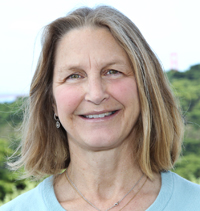Dr. Karla Kerlikowske, a professor of medicine at UCSF's School of Medicine who also practices at the Veterans Affairs Medical Center, is the principal author of the study and a leading researcher in the field of breast-cancer screening. She says the benefits of screening low-risk women every year – catching some cancers at an earlier state, when treatment may be easier and more successful – don’t outweigh the drawbacks – a very high rate of false positives.
“Whether you’re 40 or 50, your chance of having at least one false positive – you could have more, but your chance of having at least one – is 60%,” Kerlikowske says. “So more than half of all women are going to have at least one false positive (over the course of a decade) if they’re screened every year. And you can reduce your chance of that if you have mammography every other year.”
A woman who has a false positive screening will usually get a second diagnostic mammogram, and sometimes an ultrasound. If those still don’t rule out cancer, and the next step is a biopsy. Kerlikowske’s study found that about one in 12 women who have a false-positive mammogram will be referred for one. Many breast biopsies nowadays are outpatient procedures requiring only local anesthesia and an hour or two of a patient’s time. But Kerlikowske says we shouldn’t minimize their significance.
“The bore of the needle is fairly large and some of them actually suck the tissue out,” she said. “Sometimes they have to make more than one pass with the needle, so biopsies in particular are not trivial.”
Kerlikowske also published a study a few months ago that suggested rather than making a blanket recommendation for every patient, doctors and women should consider several individual risk factors to decide how often to schedule mammograms. One risk factor that’s less well-known than family history or age is the density of an individual woman’s breast tissue.
“There’s two issues for women with dense breasts. One is that it puts them at increased risk of breast cancer. And the second is that it can mask tumors. The study we published in July in the Annals of Internal Medicine was focusing on how you can use breast density to determine how often people should be screened, and when they should start and stop screening.”
Kerlikowske says there’s still a lot of research to be done on this subject, but one conclusion her study drew was that women aged 40-49 with dense breasts should choose digital mammograms if they’re having them at all; digital mammograms makes it easier to distinguish cancers in dense tissue.
Here’s UCSF’s summary of Kerlikowske's earlier study:
KQED Radio's Forum had a lively discussion today about the risks and benefits of routine screening for prostate as well as breast cancer. You can give it a listen and join in on the message board here.
